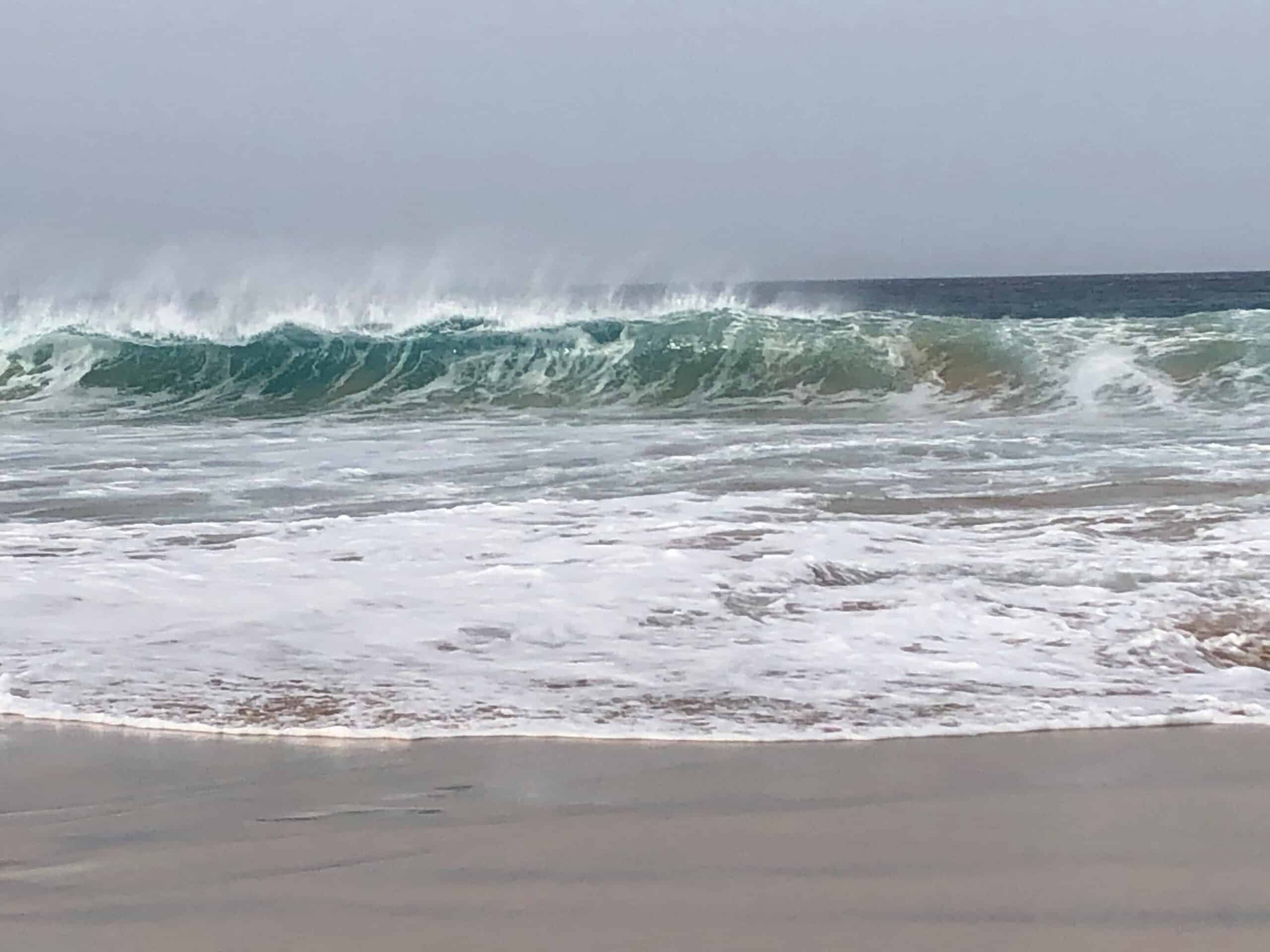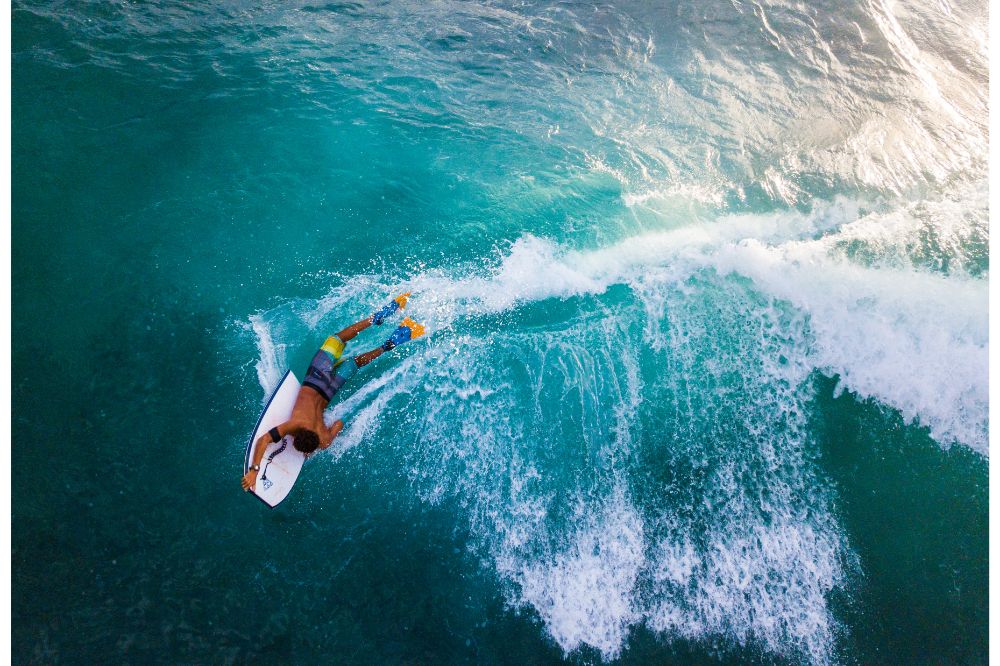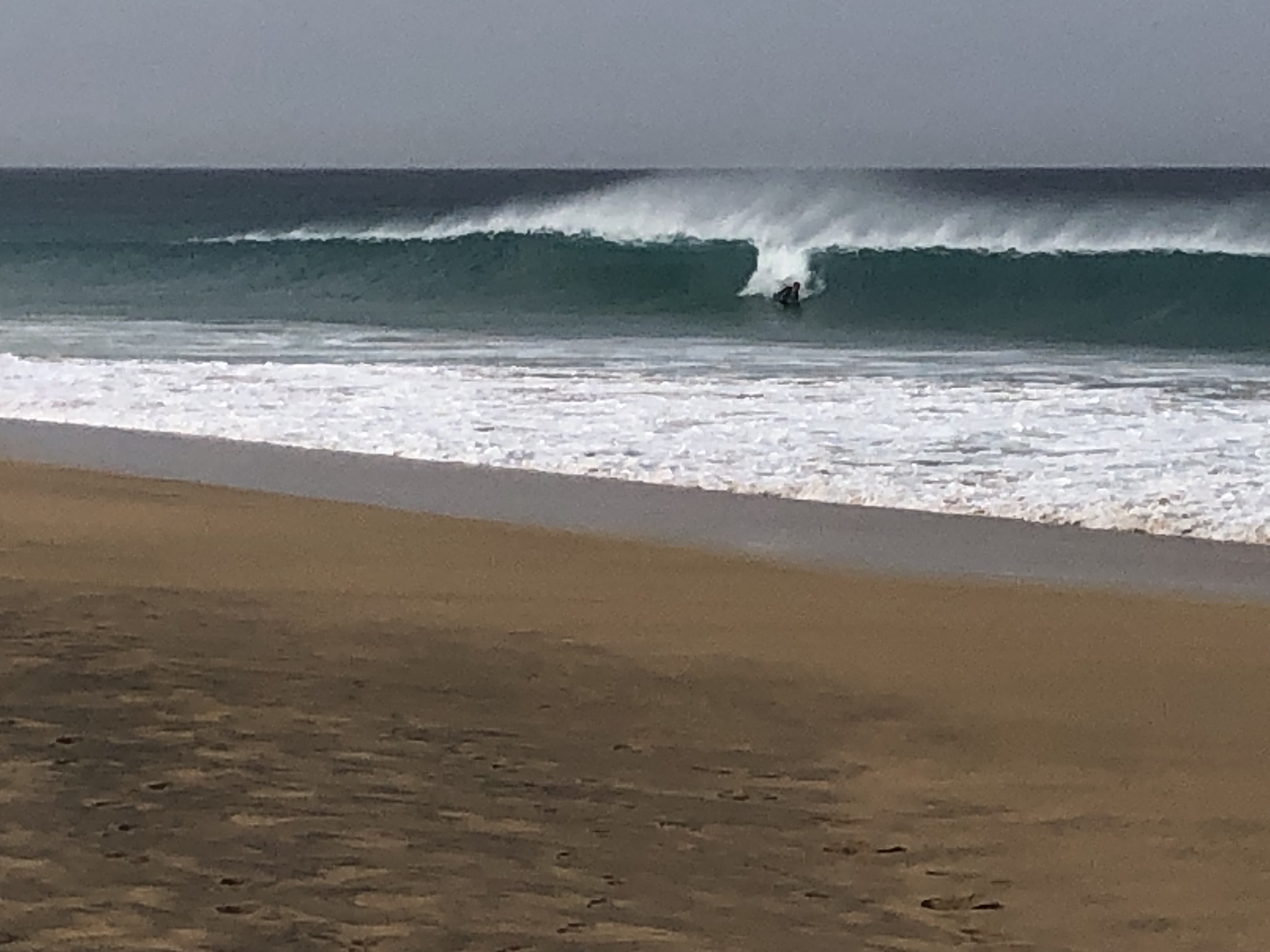Boogie boarding, also known as bodyboarding, is a fun and exhilarating water sport that’s remarkably easy to get into. Armed with just a boogie board, you can leap into the ocean’s waves and start riding.
However, before you take the plunge, there’s one crucial factor to consider: wave size.
As a beginner, you might think that the bigger the wave, the more fun it will be. This could be true, but it might also set you up for an unpleasant experience. The ideal wave size for boogie boarding can vary depending on one’s skill level.
Typically, waves around 2-4 feet high are considered good for beginners while more experienced boogie boarders may prefer larger waves, often around 5-6 feet.

However, as a true beginner, you can start with bodyboarding on 1ft waves. Although the rides are likely going to be short and not very intense, even these really small waves allow you to learn about the timing you need to catch a wave and to develop a feeling for lying and riding on the board.
As skills improve, larger waves can provide a more thrilling experience. Even if you’re a pro at maintaining your balance on the boogie board, if the waves aren’t just right, you might find yourself simply floating. Let’s dive deeper into understanding boogie boarding and how wave size comes into play.
Understanding Boogie Boarding
Boogie boarding, also known as bodyboarding, is a thrilling water sport that utilizes a small, almost rectangular board to catch and ride waves back to shore. Typically, a rider will lie flat on the board and use their legs and arms for steering and balance.
It’s a fun and accessible way to experience the rush of surfing without needing extensive training or a large dose of bravery. Understanding the basic technique is vital to help you balance on the board and keep the maneuverability on the water.
Therefore, boogie boarding uses the wave’s dynamic power to drive the board rather than the rider’s own strength.
It means that the wave size and power are paramount to catch and successfully ride a wave back to shore. In this context, the central role of waves in boogie boarding can’t be questioned.
But how big do these waves need to be to boogie board effectively?
Well, that’s a fascinating subject that needs a deeper dive. That’s what we’ll explore next.
The Role of Wave Size
Let’s engage in a chat about the role of wave size when it comes to boogie boarding. In the grand scheme of things, it has a significant impact on your overall boogie boarding experience. Whether the waves are large or small, they each serve a purpose and create unique challenges for boogie boarders.
Wave Size for Beginners
Small waves between 1-3 feet with an interval of 6 – 8 seconds and more, are perfect for beginners.
They’re not too powerful, allowing newbies to get a hang of the sport while navigating the ebb and flow with ease. These smaller waves let the rookie boarders focus on their balance, basic techniques, and learning how to ride without getting overwhelmed by the ocean’s might.
Wave Size for advanced Boogie Boarder
On the other side of the spectrum, large waves, in the 6 feet and above range, bring a different kind of adventure.
They offer the opportunity to perform tricks and high-speed runs. Experienced boarders find these more thrilling, though they definitely require a higher skill level and confidence while out in the water.
Wave Size for everyone
In between are the medium-sized waves, roughly 3-6 feet, and an interval of about 5 to 8 seconds.
These are popular among all levels of boogie boarders as they guarantee an exciting ride without being too hazardous, blending a harmonious mix of safety with fun and challenge.
So, no matter what size the wave, there’s a place for every kind of boogieboarder to enjoy the sport while leveling up their experience.
Determining the Ideal Wave Size
So, what’s the ideal wave size for an epic boogie boarding experience?
Well, it all depends on your skill level and personal preference. The beauty of boogie boarding is that it’s versatile. You can carve your ride on the ocean’s surface with smaller waves, or you can dive into the thrill of larger waves for a more adrenaline-fueled run.
Beginner Wave Size

If you’re a beginner, start small (ideally 2 – 3 ft wave height and intervals between 6 – 8 seconds).
Gentle waves, typically between two to three feet high, offer the perfect playground.
They’re manageable and forgiving, giving you the chance to work on your balance, timing, and basic techniques without the intimidating factor of larger water walls.
But since these small waves forgive some mistakes, especially when entering them, it is important to take care of the right technique and timing from the beginning. Because if you have this under control, the increase in larger waves will be correspondingly easier for you.
When you’re getting more advanced in Bodyboarding
Got the hang of riding those smaller waves?
Great!
Now you can graduate to medium-sized waves. Waves of about three to six feet are excellent for intermediate riders.
However, make sure that the interval, which means the time between waves, is more like 6 seconds or more (the more the better)when you first venture into the bigger waves. Such waves are fun, challenging but not overly risky. You can experiment here, perfecting your turns and spins and having a great time while doing it.
Wave Size for the Pro Boogie Boarder
For more experienced riders, larger waves are where the real excitement lies.
Waves of six feet and above (also with shorter intervals) provide the speed and power that can be thrillingly exhilarating.
Here, you’ll have the opportunity to execute advanced maneuvers, ride in the tube, and truly capture the spirit of boogie boarding. However, do keep in mind that with greater wave size comes increased risks. Always ensure you prioritize safety.
What else is important besides the height of the Wave
But remember, the perfect wave isn’t just about height.
It’s also about the quality of the wave – its shape, power, speed, and the time between swells.
A beautifully formed wave, regardless of its size, can offer a memorable ride. Start paying attention to these factors, you’ll soon develop an innate sense to pick the ideal wave for your ride.
Every wave is as unique as the rider tackling it on their boogie board, and part of the challenge – and fun – is learning to adapt to different conditions. So, grab your boogieboard, hit those waves, and find your perfect ride. After all, boogie boarding is not a one-size-fits-all sport – it’s about tailoring the experience to your skill level and style. Don’t be afraid to dive in and test various wave sizes.
You’ll find your sweet spot soon enough!

Wave Measurement and Terminology
As you journey further into the world of boogie boarding, you’ll quickly understand the importance of wave measurement and different terminologies. This knowledge is vital when it comes to riding waves on your boogie board as it allows you to anticipate wave patterns and choose the most suitable conditions for boogie boarding.
Important aspects of a Wave for Boogie Boarding
Wave measurement often involves two distinct aspects – the height and length.
The height of a wave is the distance from its peak to the trough (on the back side of the wave when using the Hawaiian method), which directly influences its potential energy. Larger waves generally present more power and speed, promising both thrills and challenges for boogieboard riders. However, if you’re just starting with boogie boarding, smaller waves are recommended as they are easier to navigate and maneuver.
Wave length, on the other hand, refers to the distance between successive crests. It affects the speed at which waves travel and break. A longer wave length results in a slower-moving wave, allowing beginners more time to get on the boogie board and ride the wave.
Terminology
Now, let’s dip our toes into some wave terminology.
You may hear seasoned boogie boarders use terms like ‘swell’, ‘break’, and ‘rip’.
A swell refers to a series of waves traveling from a distant storm.
The break is when those swells reach shallow water, causing them to slow down and increase in height until they eventually collapse or ‘break’.
Rips, short for rip currents, are strong, narrow currents flowing out to sea. They can pose a danger to boogie boarding, particularly to individuals unfamiliar with the sea conditions.
Last but definitely not least, the term ‘tube‘ refers to the hollow part of the wave that forms as it breaks, often seen as the ‘holy grail’ of wave sports, encompassing you in a world entirely on its own.
By understanding wave measurements and terminology, you’ll be able to predict wave behavior more accurately and gain confidence in selecting the best waves to boogie board. After all, boogieboarding isn’t just about riding the waves–it’s about understanding them too!
Conclusion
In summing up, the perfect wave size for boogie boarding varies.
Smaller waves are ideal if you’re a beginner, giving you a gentle introduction to the sport. As you gain more skills and confidence, try riding bigger waves. Just remember that it’s not all about size – the quality of the wave matters too. Swell consistency, speed, and shape all affect your ride.
The aim is to find waves you’re comfortable with and improve your skills in a safe environment. Trust your instincts, and above all, enjoy the ride. Whether you’re catching a 2-foot ripple or a 6-foot monster, boogie boarding is all about having fun. As you master the art of boogie boarding and gain more knowledge about waves, you’ll find that the ocean is your playground.
Take the time, and you’ll see, sizing up your waves will soon become second nature. So grab your boogieboard and hit the waves, it’s an adventure you wouldn’t want to miss!






